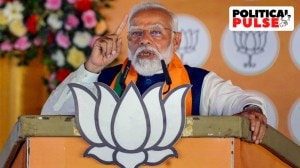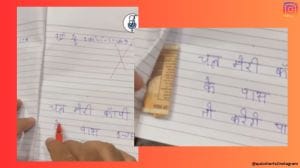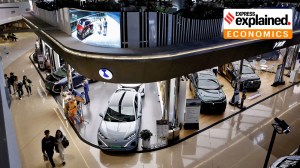- India
- International
Raja Mandala: In his second term, Modi must deal with turbulence unleashed by Trump’s challenge to global trading order
Modi needs to take a strategic view of India’s foreign trade, purposefully explore the possibilities for give and take with the US, and seize on the rearrangement of global production chains in the wake of the US-China trade war. No other set of issues will shape India’s future global trajectory more than a pragmatic reorientation of India’s trade strategy and the reformation of its negotiating structures.
 If Modi had a predictable international environment in the first term, he must now deal with a far more dynamic external situation. (C R Sasikumar)
If Modi had a predictable international environment in the first term, he must now deal with a far more dynamic external situation. (C R Sasikumar)
In his first term as prime minister, Narendra Modi helped re-energise Indian diplomacy that had begun to lose momentum in the final years of the UPA government. But Modi did not have to alter the essential foreign policy tenets that were developed by his predecessors, Manmohan Singh, Atal Bihari Vajpayee and P V Narasimha Rao after the end of the Cold War. He simply had to build on them.
If Modi had a predictable international environment in the first term, he must now deal with a far more dynamic external situation. The instabilities that have been visible over the last two years are now becoming acute by the day. But the moment of great global disruption — marked by the structural changes in great power relations and the global economic order— also presents strategic opportunities for Delhi.
But first, to Indian diplomacy in Modi’s first term. If there is one word to describe it, “bold” comes readily to mind. Delhi’s ability to take full advantage of the many opportunities that came India’s way — with the US, China and Pakistan — during the UPA years were undermined by the Congress leadership’s ambivalence and self-doubt.
Modi, in contrast, was ready to take decisive steps on all three fronts. Modi ended India’s “historic hesitations” towards the US by expanding the strategic partnership with Washington, confronted the sources of terrorism in Pakistan and was ready to stare down at China in the military stand-off in Doklam.
Equally important was Modi’s emphasis on resolving problems that the UPA government had left behind. These included the ratification of the land boundary agreement with Bangladesh and wrapping up the civil nuclear initiative with the US. The Modi government sorted out the messy Italian Marines Case that was undermining India’s engagement with Europe as a whole and blocking India’s quest for membership in various international bodies like the Missile Technology Control Regime. The government also took a more practical approach to climate change negotiations by ending India’s negativism and initiating the International Solar Alliance.

Delhi will need all of Modi’s problem-solving skills in coping with the new foreign policy challenges confronting India. None of them are more important than the return of the great power rivalry and the crisis in the global trading order.
The end of the Cold War and the collapse of the Soviet Union in 1991 had liberated India from the multiple constraints of the Cold War. This left India free to salvage ties with Russia from the debris of Soviet Union, and expand ties with the US and its allies in Europe and Asia, and normalise the relationship with China.
While the rhetoric of Non-Alignment endured in the discourse in Indian foreign policy, it was replaced, in practice, by a multi-directional engagement of all major powers. India was happy to be best friends forever with all powers. That will be hard to sustain as great powers begin to squabble among themselves.
Until recently, you could buy advanced military aircraft from America and air-defence missiles from Russia. Now the purchase of S-400 missiles from Moscow invites sanctions from Washington. This is just the beginning. If the US-Russia relations deteriorate further, the problem of navigating between them will get more demanding.
The scope and consequences of US-Russia rivalry pales in comparison to the gathering conflict between America and China. Few countries watched the normalisation of US-China relations in the 1970s and the expansion of economic and political ties over the last four decades between Washington and Beijing with greater anxiety than India.
A section of the Indian foreign policy elite in Delhi could never stop griping about America’s strategic preference for Beijing during the last decades of the 20th century. As the US looked to India to balance China in Asia and the Indo-Pacific in the 21st century, the UPA government seemed reluctant to cash in India’s new geopolitical leverage. Modi has certainly ended a lot of that timidity by opening up to a stronger partnership with the US. The US, in turn, has been more responsive to India’s concerns about cross-border terrorism and its aspirations for a larger regional role and the quest for a seat at the global high table.
While Modi’s Delhi may be well positioned to cope with the current geopolitical disruption and is open to coalition building with the US in the Indo-Pacific, it appears utterly unprepared to deal with the turbulence on the geo-economic front, generated by President Donald Trump and his challenge to the global trading order. At the turn of the 1990s, India opened up its economy and began to adapt, kicking and screaming, to the prevailing “Washington Consensus” on economic globalisation. But central to Trump’s worldview is the proposition that the “Washington Consensus” has been bad for American people and other nations have taken unfair advantage of America’s open markets. Over the last two years, he has sought to undermine the WTO, restructure the North American Free Trade Agreement with Mexico and Canada and walked out of the Trans-Pacific Partnership. To top it all, he has now embarked on a full-blown trade war with China — the world’s second-largest economy. He has not spared the most important US allies — including Germany and Japan — from his confrontationist trade policies.
India is very much at the top of Trump’s list of trade targets; it is no secret that Trump has been waiting for the new government to take charge. For the traditionalists in India, the answers lie in affirming the mantra about “multilateralism” and mobilising the mythical G-77 to counter the US “unilateralism”.
Realists in Delhi would see the world is at a new juncture on trade. They would recognise that India’s dharma is not about defending the WTO to death. With its annual trade in goods and services now at more than one trillion dollars, Delhi’s duty is about protecting India’s trade equities that are now so critical for the economic well being of its population.
Modi needs to take a strategic view of India’s foreign trade, purposefully explore the possibilities for give and take with the US, and seize on the rearrangement of global production chains in the wake of the US-China trade war. No other set of issues will shape India’s future global trajectory more than a pragmatic reorientation of India’s trade strategy and the reformation of its negotiating structures.
This article first appeared in the print edition on May 25, 2019 under the title ‘Diplomacy amid disruption’. The writer is director, Institute of South Asian Studies, National University of Singapore and contributing editor on international affairs for The Indian Express.
40 Years Ago
EXPRESS OPINION
More Explained
Apr 16: Latest News
- 01
- 02
- 03
- 04
- 05









































